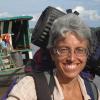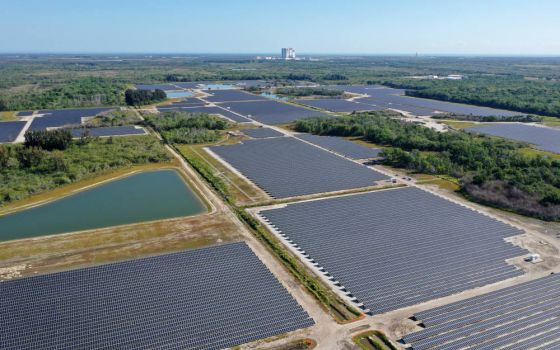
(Unsplash/Markus Spiske)
Editor's Note: EarthBeat Weekly is your weekly newsletter about faith and climate change. Below is the Oct. 8 edition. To receive EarthBeat Weekly in your inbox, sign up here.
From time to time, I hear something that makes me think about the world in a different way. That happened this week, when I watched a presentation by May Joseph, a professor of social science and culture, about sand.
It struck me, because I live in a desert — Lima, Peru, is the largest desert city in the world, just after Cairo. And sometimes I long for more greenery, even as I cringe when I realize that people water their gardens with tap water in a region where water is scarce.
Joseph, who spoke at a virtual event sponsored by Columbia University, spent years living in Qatar and speaks poetically of the country's sand dunes. She is also critical of the use of the word "desert" — a term that she associates with the Saharan countries' colonial past, which conjures images of a harsh, empty expanse of land. In fact, she says, those drylands have a life of their own, and she prefers calling the region the Sahara biome.
The grains of sand in that biome might be tiny, but they have an outsize impact on the planet as seasonal winds carry them long distances.
The Sirocco winds, which blow northward from northern Africa and have different names in different places, carry dust across the Mediterranean countries and can reach as far as Britain. The Shamal wind deposits sand across the Middle East.
And then there is the Harmattan, a trade wind that blows westward from western Africa, carrying dust as far as the East Coast of the United States, parts of the Caribbean and the Amazon Basin.
Scientists estimate that 400 million to 700 million tons of dust are swept up from African drylands every year and settle over the planet's surface, with some 60 million being carried westward across the Atlantic.
Although these dust-laden winds are a health hazard for humans, they are a crucial source of ecosystem nutrients, depositing phosphorus, calcium, potassium and iron that fertilize forests and oceans.
But a warming climate could change that. Scientists predict that warmer oceans could slow the Saharan winds, reducing both the amount of dust they pick up and the distance it travels. This would also reduce the amount of nutrients reaching distant ecosystems. The airborne layers of dust also reflect sunlight, helping to cool the planet, so a reduction could contribute to further warming.
The dust storms are a reminder of how interrelated Earth's systems are, and how the disruption of one can have consequences in distant places. They also remind us that humans are part of these systems, not above or outside of them, and that the human activities warming the climate have impacts on people in places we can barely imagine.
That has been a constant theme in Pope Francis' messages, especially documents like Laudato Si' and Querida Amazonia. And Francis, who studied chemistry, is clearly comfortable talking with scientists about these relationships and adding a moral message to the scientific facts.
On the Oct. 4 feast of his namesake, St. Francis of Assisi, the pope joined nearly 40 leaders of various faith traditions in signing and delivering a declaration calling for governments to take strong action on climate change at the November U.N. climate conference in Glasgow, Scotland. They also pledged to work with their congregations to increase awareness of and engage in action on climate issues, writes NCR environment correspondent Brian Roewe.
Just a few days later, reports Carol Glatz at Catholic News Service, Pope Francis launched an academic program at Rome's Pontifical Lateran University aimed at contributing to an "ecological conversion." He also urged universities around the world to take an interdisciplinary approach to education for sustainability.
When I read Glatz's story, I was reminded of Joseph's description of the sand dunes and their place in the global scheme of things. She is a social scientist and performance artist, not a geologist or climatologist, yet she spoke poetically about both the art and the science of Saharan sand.
She told her listeners that humans need a new relationship with that dust — a new ethic and a new aesthetic of sand, as she put it. We can probably say that about the relationship of most humans with much of the natural world.
Although Francis will not be taking his moral message in person to the Glasgow summit, as Catholic News Service reported Oct. 8, the faith leaders' appeal will undoubtedly echo among activists attending the event. When they urge the world's leaders to listen to the cry of the Earth and the cry of the poor, they are talking to all of us.
Here's what else is new on EarthBeat:
- Two congregations of Franciscan sisters — one in Iowa, the other in Minnesota — both preserved some of their land through conservation easements. But while their motivations and the end result were the same, the congregations chose different paths, writes Roewe in the second part of EarthBeat's special series "An Estate Plan for the Earth."
- In a commentary, Alex Mikulich writes that tempting as it may be, we need not resort to apocalyptic cynicism — our greatest hope for the life of Mother Earth is in our own rootedness in her awesome regenerative life systems.
- And Brenna Davis and Michael Downs of the Ignatian Solidarity Network close the Season of Creation with a final reflection for EarthBeat's "At Home in Creation" series, reminding us that we sustain our "happy places" — those places in God's creation where we feel rooted — when we take radical delight in them.
- Steve Karnowski at The Associated Press reports on a lawsuit filed by six Native American tribes in an effort to stop the hunting of wolves — an animal they consider sacred — in Wisconsin.
- Meanwhile, a federal judge dismissed a lawsuit filed by the Adorers of the Precious Blood in Pennsylvania, who sought to collect damages for a pipeline built across their land over their objections, writes Dennis Sadowski at Catholic News Service.
- CNS also reports that two Philippine bishops have warned that rising seas and excessive depletion of groundwater are causing Manila to sink, putting millions at risk of flooding and displacement.
Advertisement
Here's some of what's new in other climate news:
- Two winners of this year's Nobel Prize for physics were honored for their groundbreaking work in predicting what would happen to Earth's climate as carbon dioxide builds up in the atmosphere, modeling the forces that cause climate change. David Keyton and Seth Borenstein have the story for The Associated Press.
- Deepa Shivaram at NPR reports that President Joe Biden restored the boundaries of two protected areas in southern Utah, Bears Ears and Grand Staircase-Escalante monuments, which had been downsized by the Trump administration.
- The U.N. Human Rights Council declared access to a clean and healthy environment a basic human right and created a new special rapporteur on climate change, reports Emma Farge for Reuters.
- The United States is one of the biggest plastic manufacturers, and also one of the biggest plastic polluters, but it trails much of the world in legislation to rein in that contamination, writes Hanna Seo for Environmental Health News.
- A massive backup of cargo ships off the coast of California, caused by supply-chain disruptions, has resulted in a spike in air pollution, and an anchor dragged by one of those ships may have caused a pipeline oil spill that has fouled coastal wetlands, reports Maria Gallucci at Grist.
- And Nia Williams at Reuters reported that the Enbridge's controversial Line 3 oil pipeline began operating this week in Northern Minnesota.
Upcoming events:
This week's events include a morning of creation-centered prayer and reflection and a conversation between the president of the University of San Diego and oceanographer Michel Boudrias. I'll also be talking about what Catholics should know about November's U.N. climate conference as part of an "Ecospirituality in Action" series sponsored by the Franciscan Sisters of Perpetual Adoration.
You can fine more information about these and other events on EarthBeat's Events page, and you can add your group's event here.
Closing beat:
Is your parish or faith group planning any educational or other activities related to the November climate conference? If so, we'd like to hear about them. Drop us a line at earthbeat@ncronline.org.
Thank you for reading EarthBeat!






